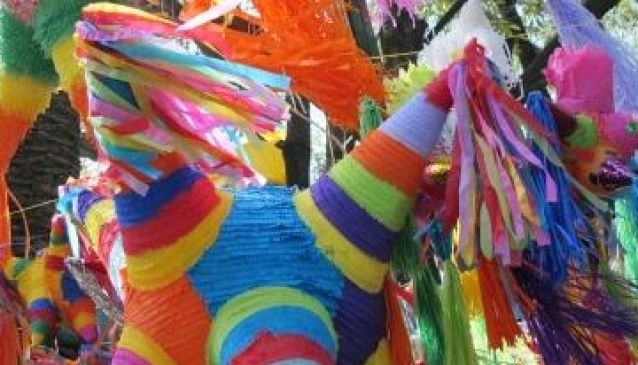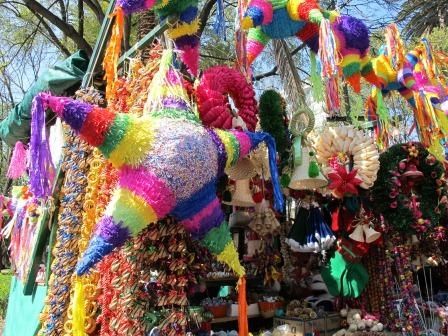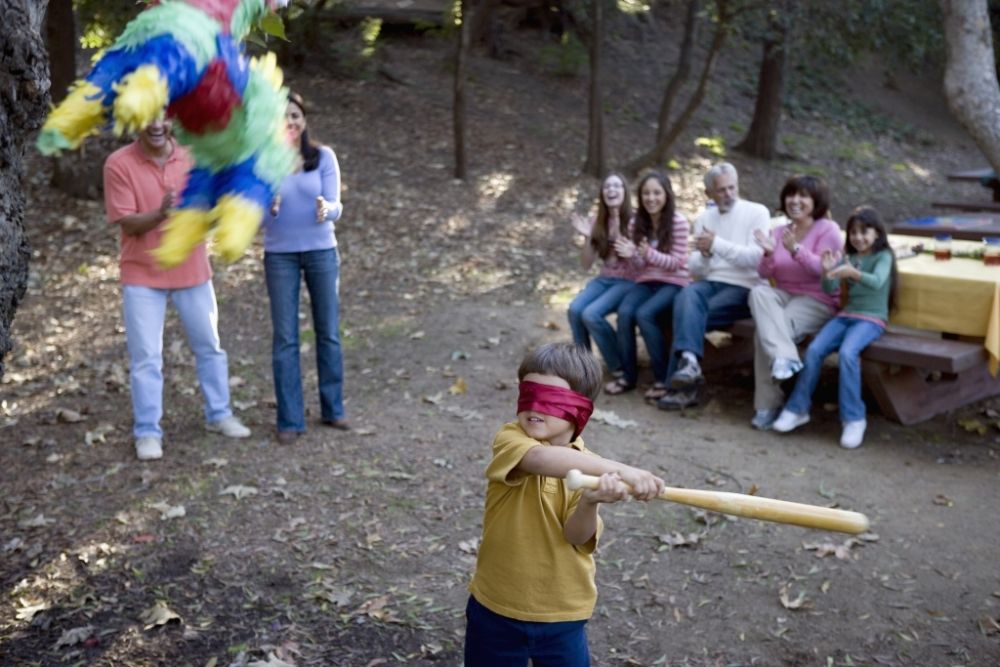Tradition and culture explain the Mexican piñata phenomenon...

The piñata is one of the many typical traditions of Mexico. A piñata is a clay pot filled with sweets, fruit and little toys, and is decorated with colored paper. Mexican children love piñatas as they associate them with Christmas, birthdays and fiestas.
To break a piñata a rope is thrown over a branch and it is then tied up so an adult can pull the rope up and down while a child wearing a blindfold tries to break the piñata with a stick. The children take it in turns, while the rest of the group clap and chant a piñata song that may sound like this
This means something like:
Other very popular song is:
Many people say that the piñata originated in Spain and was brought to Mexico by the Spanish conquerors at the beginning of the 16th century. The Spanish missionaries used the piñata as a tool to attract converts to their religion. They found that the Mexican Indians already had a similar tradition for the Aztec god of war, Huitzilopochtli.

Piñata de estrella
In this tradition the Indian priests placed a clay pot on a pole in the temple at the end of the year and decorated it with feathers. When broken with a stick or club, the treasures would fall to the feet of the god's image as an offering. It was not only the Aztec’s but also the Mayans, who were enthusiastic sportsmen, that acted out this tradition. The Mayans used to play a game where the player was blindfolded while he tried to hit a clay pot suspended by string.
Our conquerors found in piñata´s the perfect match to attract the locals into their religion, and made variations on the meanings and symbolism of this act to convert it into a tradition that has been kept alive in México for centuries. I have enjoyed piñatas all my life but more during Posadas (a special and traditional celebration done before Christmas Eve). And I always remember what my mother taught us about the symbolism of our Mexican piñatas. She used to say that the clay pot represents Satan who often wears an attractive mask and bright colors to attract humanity. She also says that the traditional piñata is built with seven cones, each with streamers, and they represent the seven deadly sins, which are - greed, gluttony, sloth, pride, envy, wrath and lust.
The blindfolded participants, who are mostly the children from the fiestas, represent the force of faith that has to defy evil. People that gather around the blindfolded and the piñata must confuse his sense of space and sing out incorrect instructions. This has also a meaning since the incorrect instructions represent humans that would sometimes give us incorrect advice. The stick which is used to break the piñata represents and symbolizes love. It is supposed to destroy the sins by hitting and breaking the piñata into pieces. The candies and treats that come pouring out from the broken piñata symbolize the forgiveness of sins and a new beginning. To confuse faith, after a couple of minutes if the participant doesn’t break the piñata another one would come forward and the same steps should follow, until finally the evil is defeated and the candies and fruits represent the rewards we gain when we overcome temptations.

Whenever the piñata is broken open, the children rush in to it to gather up the sweets and fruit which lie scattered over the ground. Although this tradition is still alive, some variations have arrived, now modern piñatas are represented by cartoon characters popular with most children, and now more often than not you will find political characters that are satirized and used for grown up fiestas, In fact there is no limit to the imagination for piñatas. According to local records, the piñata was first used for evangelistic purposes in 1586, in Acolman, just north of Mexico City. The Augustinian monks there modified European piñatas, along with creating the December Posada tradition to co-opt the celebration of the birth of the god Huitzilopochtli, which was celebrated in mid-December. Nowadays, Acolman hosts an annual National Piñata Fair.
The art of making piñatas falls under the Mexican hand craft heading of cartonería, which refers to the making of items from paper and cardboard. You can find our traditional handmade piñatas at The Museo de Artes Populares (Popular Art Museum) in Mexico City this museum works very hard to maintain Mexico’s popular traditions. Piñatas can be bought in almost any Mexican popular market.